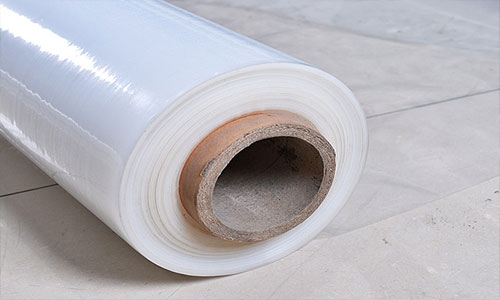PE protective film surface materials can be divided into two main categories: paper and film.
The die-cutting of PE protective film made of rough paper is slightly different from that of film materials. Although theoretically, the surface material and adhesive should be die-cut together by the PE protective film manufacturer, in practice, die-cutting paper materials is a combination of blade cutting and paper tearing. This means that the cutting of the blade also pushes the paper towards both sides, resulting in lower precision in die-cutting paper materials. Often, some labels have burrs due to the rough fibers and natural breakage of the material.
The application of die-cutting PE protective film with different types of surface materials
Based on the die-cutting characteristics of paper-based materials, and considering the wear of the blade, the angle of the die-cutting blade used by PE protective film manufacturers is set at 52°. A larger angle would cause more material extrusion deformation, leading to a decrease in the differentiation phenomenon of identification.
For film-based materials, die-cutting is a process of completely cutting through the material. Since most film materials are flexible and will not naturally break, cutting two-thirds of the material is not appropriate. It should be cut or trimmed to four-fifths of its thickness. Otherwise, it will peel off with the label.

The strength of the surface material of PE protective film is related to the thickness, fiber (polymer) structure, and moisture content of the material itself. In the die-cutting process of PET protective film materials, the factor associated with the surface material is the waste discharge speed. The higher the humidity, the weaker the strength of the PE protective film material after being dampened, and it may break easily or even be unable to discharge waste.
The application of die-cutting PE protective film with different types of surface materials
When designing the layout of PE protective film, the strength of the material should be considered, and reasonable arrangements for waste discharge size and speed should be implemented. This not only improves production efficiency but also increases material strength.
The thickness of the surface material of PE protective film directly affects the depth of the die-cutting. The thicker the material, the more difficult it is to die-cut. Because the thicker the material, the larger the tolerance of the die-cutting, and the smaller the probability of cutting through the bottom paper. In comparison, thinner materials are more prone to cut through the bottom paper. For example, when differentiating between die-cutting 80g/㎡ and 60g/㎡ on the same bottom paper using a flatbed label die-cutting machine, it was found that die-cutting 80g/㎡ materials had normal waste discharge, but when switching to 60g/㎡ materials, there were frequent cases of waste discharge breakage, bottom paper cutting, and loss of labels, requiring frequent machine stops for blanket adjustments, resulting in significant waste. There are multiple factors that may cause this situation, such as using round press-cutting methods or reducing the die-cutting area, or using high-precision equipment by the PE protective film manufacturer, which can increase or avoid these phenomena.
Contact: Pamela
Phone: +86 189 6365 3253
E-mail: info@industryprocess.com
Whatsapp:+86 189 6365 3253
Add: Yajing Industrial Park, No. 59 Shuangjing Street, Weiting Town, Suzhou Industrial Park
We chat
